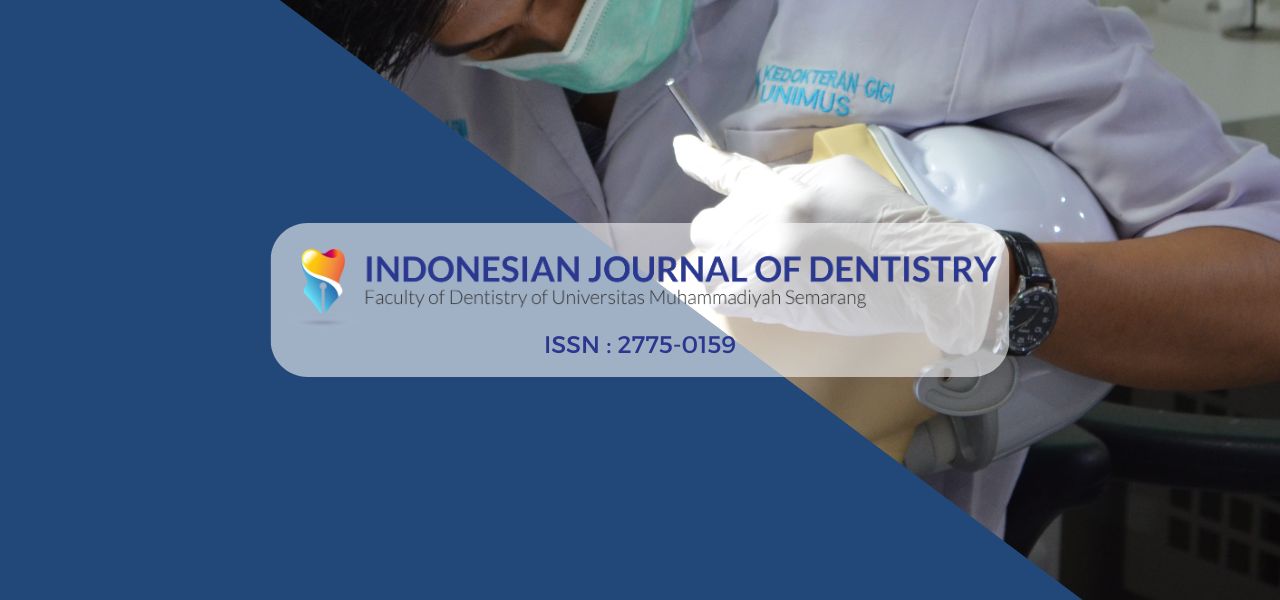THE INHIBITORY EFFECT OF BAMBOO CHARCOAL EXTRACT ON THE GROWTH OF STREPTOCOCCUS MUTANS
(1) Universitas Muhammadiyah Semarang
(2) Universitas Muhammadiyah Semarang
(3) University Muhammadiyah Semarang
(4) University Muhammadiyah Semarang
(*) Corresponding Author
Abstract
ABSTRACT
Background: Streptococcus mutans is the primary cause of dental caries due to its acidogenic and aciduric properties. Natural antibacterial agents, such as bamboo charcoal extract, have been explored as potential alternatives to synthetic antimicrobial agents. However, the effectiveness of bamboo charcoal extract in inhibiting Streptococcus mutans remains uncertain. This study aimed to evaluate the antibacterial potential of bamboo charcoal extract at various concentrations.
Methods: This research was conducted using a laboratory experimental method. The number of samples per group was determined using the Federer formula (t−1)(n−1)≥15, where t is the number of treatment groups and n the number of replications. With seven groups (six concentrations of bamboo charcoal extract and one positive control), a minimum of three replications per group was required, resulting in 21 samples in total. Bamboo charcoal extract was prepared through maceration using 96% ethanol and tested at concentrations of 0%, 12.5%, 25%, 37.5%, 50%, and 62.5% against Streptococcus mutans using the disk diffusion method. A 0.2% chlorhexidine solution served as the positive control. Inhibition zones were measured after a 24-hour incubation at 37°C.
Results: Statistical analysis using descriptive analysis showed no significant difference in inhibition zones. None of the bamboo charcoal extract concentrations demonstrated antibacterial activity against Streptococcus mutans. In contrast, the positive control (0.2% chlorhexidine) produced a significant inhibition zone of 12.56 mm.
Conclusion: Bamboo charcoal extract at concentrations of 12.5%, 25%, 37.5%, 50%, and 62.5% did not show any inhibitory effect on the growth of Streptococcus mutans.
Keywords
Full Text:
PDFReferences
U. Lestari, S. Syamsurizal, and Y. Trisna, “The Antiplaque Efficacy and Effectiveness of Activated Charcoal Toothpaste of Elaeis guineensis in Smokers,” Indones. J. Pharm. Sci. Technol., vol. 1, pp. 75–87, 2021.
BPS, “Dalam Angka Dalam Angka. Kota Kediri Dalam Angka.”
O. Fejerskov, B. Nyvad, and E. Kidd, Dental caries: the disease and its clinical management. John Wiley & Sons, 2015.
J. A. Lemos et al., “The biology of Streptococcus mutans,” Microbiol. Spectr., vol. 7, no. 1, pp. 10–1128, 2019.
M. Minarni and D. Rosmalia, “Uji daya hambat antibakteri ekstrak bonggol nanas terhadap bakteri streptococcus mutans,” J. Kesehat., vol. 13, no. 1, pp. 159–163, 2022.
F. Maghfirah and D. Saputri, “Aktivitas Pembentukan Biofilm Streptococcus Mutans dan Candida Albicans Setelah Dipapar Dengan Cigarette Smoke Condensate dan Minuman Probiotik,” J. Caninus Dent., vol. 2, no. 1, pp. 12–19, 2017.
Y.-C. Choi and H.-S. Ahn, “Nonlinear control of quadrotor for point tracking: Actual implementation and experimental tests,” IEEE/ASME Trans. mechatronics, vol. 20, no. 3, pp. 1179–1192, 2014.
N. Fahira, Y. P. Rahayu, H. M. Nasution, and M. P. Nasution, “Uji Aktivitas Antibakteri Nanopartikel Ekstrak Etanol Daun Matoa (Pometia Pinnata Jr Forst & G. Forst) Terhadap Bakteri Streptococcus Mutans,” J. Ris. Kefarmasian Indones., vol. 5, no. 1, pp. 100–119, 2023.
J. Sabbineni, “Phenol-an effective antibacterial agent,” JOMC, vol. 3, no. 2, p. 185, 2016.
H. Prasetiawan, D. S. Fardhyanti, W. Fatriasari, and H. Hadiyanto, “Kinetic Study of Non-Isothermal Reactions on the Pyrolysis of Various Biomass Waste by using Thermogravimetric Data,” J. Bahan Alam Terbarukan, vol. 12, no. 2, pp. 147–157, 2023.
Article Metrics
Abstract view : 64 timesPDF - 29 times
DOI: https://doi.org/10.26714/ijd.v5i2.17549
Refbacks
- There are currently no refbacks.
Copyright (c) 2025 Indonesian Journal of Dentistry
 |  | Indonesian Journal of Dentistry (IJD), its website and the articles published therein are licensed under a Creative Commons Attributions-ShareAlike 4.0 International Licence. Indonesian Journal of Dentistry is published by Faculty of Dentistry Universitas Muhammadiyah Semarang (FKG Unimus). It's managed by Universitas Muhammadiyah Semarang. |

















